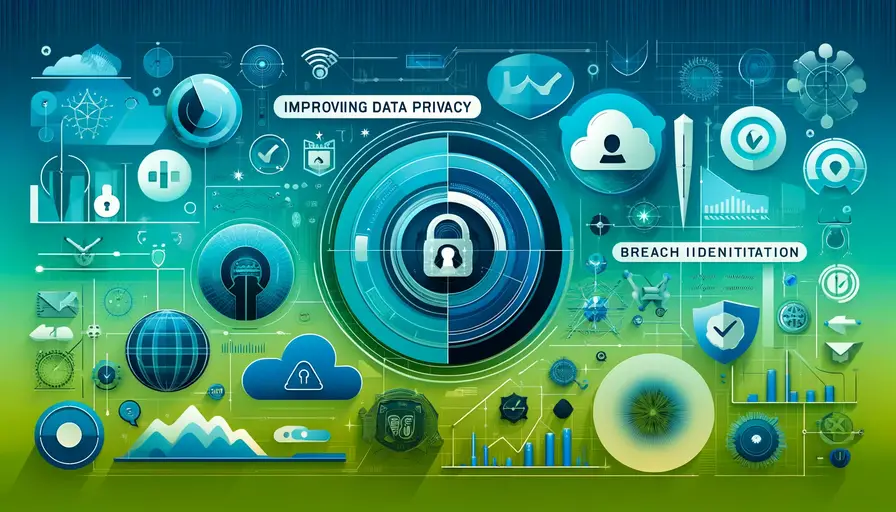
Improving Data Privacy: NLP and ML for Breach Identification

- Implement Natural Language Processing
- Apply Machine Learning Algorithms
- Develop Advanced Data Encryption Methods
- Strict Access Controls and User Authentication Protocols
- Educate About Best Practices for Data Privacy
- Establish Incident Response Plan to Address Data Breaches
- Monitor and Analyze Network Traffic for Suspicious Activity
- Regularly Conduct Security Audits
Implement Natural Language Processing
In the digital age, data privacy has become a critical concern for organizations and individuals alike. With vast amounts of sensitive information being exchanged and stored online, identifying and mitigating potential breaches is paramount. Natural Language Processing (NLP) offers a powerful toolset for analyzing text data, making it possible to detect privacy breaches efficiently. By leveraging NLP techniques, organizations can scan through vast amounts of unstructured text data, such as emails, documents, and social media posts, to identify potential privacy issues.
NLP for Breach Identification
NLP involves various techniques like tokenization, entity recognition, and sentiment analysis, which can be employed to parse and understand text data. For instance, entity recognition can help identify sensitive information like social security numbers, credit card details, and personal addresses within documents. Sentiment analysis can detect unusual or suspicious communications that may indicate a breach. Implementing NLP for breach identification not only automates the process but also increases accuracy and efficiency compared to manual methods.
Machine Learning for Breach Detection
Integrating Machine Learning (ML) with NLP enhances the capability to detect data breaches. Machine learning models can be trained to recognize patterns and anomalies in text data that are indicative of a breach. These models improve over time as they are exposed to more data, continually refining their accuracy. For example, supervised learning techniques can be used to train models on labeled datasets where breaches have been identified, allowing the system to learn and predict similar incidents in new data.
Apply Machine Learning Algorithms
The Role of NLP in Breach Identification
NLP plays a crucial role in preprocessing and preparing data for machine learning models. Techniques like vectorization convert text into numerical data that can be processed by machine learning algorithms. NLP helps in extracting features from text data that are relevant for breach detection, such as keywords, entities, and context. By converting unstructured text into structured data, NLP sets the stage for effective machine learning applications.
Improving Machine Learning Data QualityEnhancing Accuracy with ML Algorithms
Machine learning algorithms, such as decision trees, support vector machines, and neural networks, can be applied to classify and detect data breaches. These algorithms can analyze historical data to identify patterns associated with breaches. For example, a neural network can be trained to recognize the language and context typically found in phishing emails or fraudulent transactions. By continuously learning from new data, these models can maintain high accuracy in breach detection.
Benefits of NLP and ML in Breach Identification
The combination of NLP and ML provides a comprehensive approach to data breach identification. This integration enables automated, real-time monitoring of vast amounts of data, significantly reducing the time required to detect breaches. Additionally, it enhances the precision of breach detection by minimizing false positives and false negatives. Organizations benefit from proactive breach identification, allowing them to respond swiftly and mitigate potential damage.
Develop Advanced Data Encryption Methods
Protecting Data at Rest and in Transit
Data encryption is essential for protecting sensitive information from unauthorized access. Advanced encryption methods ensure that data remains secure both at rest and in transit. Techniques such as Advanced Encryption Standard (AES) and RSA encryption are widely used to safeguard data. By encrypting data, even if it is intercepted, it remains unreadable to unauthorized parties.
Implementing Multi-Factor Authentication (MFA)
In addition to encryption, Multi-Factor Authentication (MFA) adds an extra layer of security. MFA requires users to provide two or more verification factors to gain access to sensitive data. This could include something the user knows (password), something the user has (a mobile device), and something the user is (biometric verification). Implementing MFA significantly reduces the risk of unauthorized access, even if login credentials are compromised.
The Impact of Machine Learning on Privacy and Data SecurityRegular Security Audits and Vulnerability Assessments
Conducting regular security audits and vulnerability assessments is crucial for identifying and addressing potential weaknesses in data security. These assessments help in discovering new vulnerabilities that may have emerged and ensuring that encryption and other security measures are functioning as intended. Regular audits also help organizations stay compliant with evolving regulatory requirements and industry standards.
Strict Access Controls and User Authentication Protocols
Strict Access Controls
Implementing strict access controls is vital for ensuring that only authorized individuals can access sensitive data. Access controls can be based on user roles, ensuring that employees have access only to the data necessary for their job functions. This principle of least privilege minimizes the risk of data breaches and insider threats. Tools like role-based access control (RBAC) and attribute-based access control (ABAC) can be used to enforce these policies effectively.
User Authentication Protocols
User authentication protocols are another critical component of data security. Strong authentication mechanisms, such as password policies, biometric verification, and multi-factor authentication, ensure that only verified users can access sensitive information. Regular updates and audits of authentication protocols help in maintaining their effectiveness and addressing potential vulnerabilities.
Regularly Conduct Security Audits and Vulnerability Assessments
Regularly conducting security audits and vulnerability assessments is essential for maintaining robust data security. These activities help in identifying and mitigating potential security gaps before they can be exploited. Security audits involve reviewing access logs, examining security controls, and testing for compliance with security policies. Vulnerability assessments focus on identifying and addressing specific weaknesses in the system.
Privacy in Machine Learning with Adversarial RegularizationEducate About Best Practices for Data Privacy
Employee Education Programs
Educating employees about data privacy best practices is crucial for creating a security-conscious culture. Training programs should cover topics such as secure password management, recognizing phishing attempts, and the importance of regular software updates. Regular training sessions help in reinforcing these practices and keeping employees informed about the latest security threats.
User Awareness Campaigns
User awareness campaigns are equally important for protecting data privacy. Informing users about the importance of data privacy and how they can protect their information helps in minimizing the risk of breaches. Tips on creating strong passwords, recognizing suspicious emails, and protecting personal devices are essential components of these campaigns.
Collaborate with Cybersecurity Experts
Collaborating with cybersecurity experts ensures that organizations stay updated on the latest threats and implement effective countermeasures. Cybersecurity experts can provide insights into emerging threats, recommend best practices, and assist in developing robust security strategies. Regular consultations with experts help in maintaining a proactive approach to data security.
Establish Incident Response Plan to Address Data Breaches
Incident Response Plan
Having a robust incident response plan is essential for addressing data breaches effectively. The plan should outline the steps to be taken in the event of a breach, including identifying the breach, containing the damage, and notifying affected parties. A well-defined incident response plan ensures a swift and coordinated response, minimizing the impact of the breach.
Privacy-Ensured Knowledge Transfer in Machine Learning ModelsUtilizing NLP and ML for Breach Identification
NLP and ML can be integrated into the incident response plan to enhance breach detection and response. By continuously monitoring data and network traffic, NLP and ML can identify potential breaches in real-time. This proactive approach allows organizations to respond more quickly and effectively to potential threats.
Continuous Monitoring and Incident Response
Continuous monitoring of network traffic and data is crucial for early breach detection. Implementing systems that analyze data in real-time helps in identifying anomalies and potential breaches as they occur. Combined with a robust incident response plan, continuous monitoring ensures that breaches are addressed promptly, reducing the risk of significant damage.
Monitor and Analyze Network Traffic for Suspicious Activity
Benefits of Monitoring and Analyzing Network Traffic
Monitoring and analyzing network traffic is a critical component of data security. By analyzing traffic patterns, organizations can detect unusual activities that may indicate a breach. This proactive approach allows for early detection and intervention, preventing potential breaches from escalating.
NLP and ML for Breach Identification
NLP and ML play a vital role in monitoring and analyzing network traffic. NLP techniques can be used to analyze log files and network data, while ML algorithms can identify patterns and anomalies indicative of a breach. This combination enhances the accuracy and efficiency of breach detection efforts.
Enhancing Transparency in Black Box Machine Learning ModelsContinuous Evaluation and Update of Data Privacy Policies
Regularly updating data privacy policies and procedures is essential to stay compliant with evolving regulations and industry standards. Policies should be reviewed and revised to address new threats and incorporate the latest best practices. Continuous evaluation ensures that data privacy measures remain effective and relevant.
Regularly Conduct Security Audits
Security Audits
Conducting regular security audits helps in identifying and addressing potential privacy gaps. Audits involve reviewing security controls, examining access logs, and testing for compliance with security policies. Regular audits ensure that security measures are functioning as intended and help in identifying new vulnerabilities.
Vulnerability Assessments
Vulnerability assessments focus on identifying and addressing specific weaknesses in the system. These assessments involve scanning for vulnerabilities, testing security controls, and implementing necessary fixes. Regular vulnerability assessments help in maintaining robust data security and preventing breaches.
Benefits of Implementing NLP and ML for Breach Identification
The integration of NLP and ML in breach identification provides numerous benefits. These technologies enable real-time monitoring and analysis, improving the accuracy and efficiency of breach detection. By leveraging NLP and ML, organizations can proactively identify and address potential breaches, enhancing overall data security.
Mastering the Art of Evaluating Machine Learning Dataset QualityThe future of data privacy and security hinges on the integration of advanced technologies like NLP and ML. By implementing these technologies, organizations can enhance their ability to detect and respond to data breaches, ensuring the protection of sensitive information. Continuous monitoring, regular audits, and a proactive approach to security are essential for maintaining robust data privacy measures. As threats evolve, so must the strategies and technologies used to combat them, ensuring a secure digital landscape for all.
If you want to read more articles similar to Improving Data Privacy: NLP and ML for Breach Identification, you can visit the Data Privacy category.



You Must Read